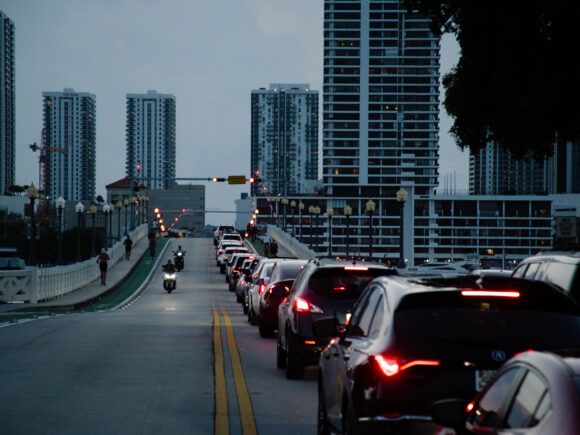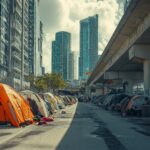Former reality TV star Fredrik Eklund zips up and down Miami in a lilac Rolls-Royce with a turquoise interior, hunting for multi-million-dollar homes for the rich and powerful.
That is, when he’s not stuck in the gridlock.
Eklund, 47, is among the thousands who have moved to south Florida in recent years, only to find themselves in the middle of one of the worst traffic messes in America. It’s a transit nightmare that’s costing commuters an average 70 hours each year, adding up to $3.1 billion in losses by one estimate.
“Schools and traffic are the two most challenging topics for the growth of real estate values and for the growth of Miami in general,” said Eklund, a former star of Bravo’s Million Dollar Listing series who moved to Miami in 2023.
Like other pandemic boomtowns, Miami has seen worsening traffic while authorities struggle to come up with mass-transit solutions to cope with the shift. But the problem is even more acute in the Florida city, where 8 out of 10 residents have a driver’s license and 90% commute by car. Traffic delays increased 18% between 2019 and 2023, partly because soaring real estate prices drove more people to the suburbs.
To fix traffic, politicians are pitching multiple rail projects, including a local version of the Northeast Corridor, the electric railroad connecting Washington to Boston.
The Northeast Corridor Rapid Transit Project is a 13.5-mile (21.7 kilometer) route from downtown Miami to suburbs up north. But the corridor will take years until operational even with the help of federal funds. The plan is to ultimately connect it to similar projects being carried out by neighboring counties and create a commuter train that extends between Miami and West Palm Beach, with multiple stops along the way.
There’s also Brightline, a privately-owned, high-speed rail backed by Fortress Investment Group that connects Miami, Fort Lauderdale, West Palm Beach and Orlando, with an expansion to Tampa in the works. But the trainline announced in May it was nixing the commuter pass program and has been prioritizing long-distance travelers. A roundtrip ticket between Miami and West Palm Beach can run about $70 depending on timing and perks, an expensive option for regular riders.
A separate railway service to the west of the Brightline, the Tri-Rail, has tried filling the commuter gap, but so far offers only limited express trips between Miami and West Palm Beach.
Local authorities are also attempting to overhaul bus systems, with Miami-Dade County set to roll out a $368 million Bus Rapid Transit corridor early 2025.
“We grew without transit,” said Miami-Dade Commissioner Eileen Higgins. “We really are an unplanned community that now needs to retrofit transit.”
Of course, cities like New York, Los Angeles and Chicago have even worse congestion than Miami. But the breakneck growth of South Florida in recent years has helped magnify the problem, creating constraints for future expansion as well as friction between private and public sectors.
Those tensions were laid bare earlier this year, when Miami-Dade’s mayor proposed a $2.5 billion bond to tackle problems for everything from housing to parks and sewage.
The Partnership for Miami, a group of business leaders that includes Ken Griffin, Orlando Bravo and members of traditional Miami dynasties like the Mas and Perez families, took issue. One of their concerns was that the borrowing plan failed to address Miami’s worsening gridlock and fund mass-transit alternatives.
The proposal, slated to be on November’s ballot, was ultimately dropped.
“I was a little surprised at how adamant they were about” traffic, said Daniella Levine Cava, the county mayor. “I mean, look, nobody likes the traffic. It’s really impossible.”
Raul Moas, president of the Partnership for Miami, said mobility projects are “critical to ensuring all Miamians have access to good jobs, quality education and essential services throughout our city.” The group is committed “to working with public and private sector leaders to bring these solutions to our community.”
Other rapidly-expanding southern cities are being plagued by similar problems.
Austin is exploring building a 10-mile, multi-billion dollar light rail system. The Austin Transit Partnership, a local government group that is helping finance the project, has faced opposition from state Attorney General Ken Paxton among others.
In Miami Beach, some residents have also pushed against mass transit projects. City commissioners voted to block connecting Miami Beach to Miami’s business district through a free tram, the Metromover, citing concerns about bringing more crime and density. The Miami Beach vote is merely symbolic because Miami-Dade County can override the city.
“Whether that does lead to an increase in homelessness and crime, that is front and center on my mind and our residents’ minds,” said Miami Beach Mayor Steven Meiner, who is reimplementing a ferry service to connect the island-city to mainland Miami.
Even in Palm Beach, one of the wealthiest enclaves in America, traffic has grown into a bigger issue.
A recent study commissioned by the Palm Beach Town Council showed an average 37,000 cars come into Palm Beach during weekdays, more than four times the local population. Congestion is set to get even worse as the city implements street blockades around Mar-a-Lago after the assassination attempt on former President Donald Trump.
Eklund, the real estate broker, said some of his clients are willing to pay a premium for South Florida real estate if it helps them avoid being stuck in a car. He still thinks traffic in other cities he has lived in, like LA and New York, is worse than in Miami.
At least in South Florida, “it might move slow, but it’s always moving,” he said. And “you still can drive and park everywhere.”
Photo: Miami Beach traffic. Martina Tuaty/Bloomberg
Anna J. Kaiser of Bloomberg helped produce this report.
Was this article valuable?
Here are more articles you may enjoy.



 South Florida Insurance Broker Pleads Guilty to Fraud in $133M ACA Enrollment Scheme
South Florida Insurance Broker Pleads Guilty to Fraud in $133M ACA Enrollment Scheme  Tesla Slumps Below 50% Share of California’s Electric Car Market
Tesla Slumps Below 50% Share of California’s Electric Car Market  Major Florida Grower to Build New Home Development After Ending Citrus Operations
Major Florida Grower to Build New Home Development After Ending Citrus Operations  Marsh Sues Aon, Ex-Team Leader Over Exit of 20 Construction Surety Employees
Marsh Sues Aon, Ex-Team Leader Over Exit of 20 Construction Surety Employees 

